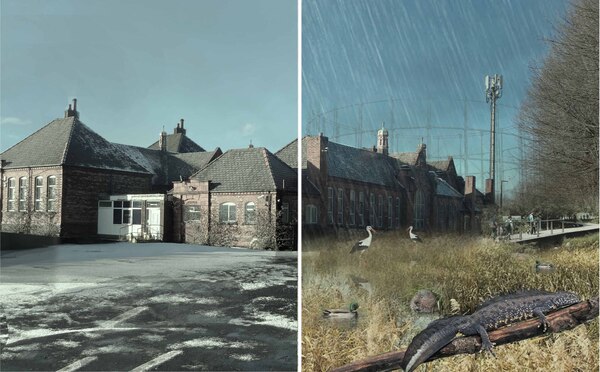The Mancunian Ark
How can water sensitive design remediate unsympathetic development?
The increasing urban sprawl within the Bradford area of Manchester has caused devastating affects for both human and non-human lives. The imbalance of permeable and impermeable surfaces have choked vegetative spaces into small islands within a sea of concrete, causing affects such as flooding, water pollution and the destruction of habitats for multiple species. This project investigates alternative development strategies. This is significant in the field of landscape and architecture, as current proposals continue to negatively impact human and non-human environments. Events such as floods are currently perceived to be problematic and something that should be fought or resisted against. However, this project questions current development patterns and how an adaptive approach can be taken in order to tackle the climate and biodiversity crises.
The concept of the design is inspired by the story of Noah’s Ark; the idea of a place of refuge for vulnerable humans and non-humans within the area.
This project is a prototype which demonstrates how alternative design solutions can tackle unsympathetic development by:
Giving water autonomy
Providing food and shelter for all
Working with seasonal cycles
Generating a circular economy
Adaptive reuse
The project has a dual mission of restoring and enhancing abandoned areas while establishing a self-sustaining food chain and circular economy. Through innovative wastewater treatment methods and creative utilization approaches, the project revitalizes the environment and addresses environmental challenges. Rain gardens collect runoff, fostering habitat for displaced species. Refuge ponds, terraces, and bioswales guide stormwater, creating safe havens and promoting cohesion. Retention ponds serve as water sources and sanctuaries during river flooding, providing homes for vulnerable species. The project removes barriers, reconnecting fragmented edges and promoting integration. The transformation replaces the parking lot with a kitchen and herb garden, pollinator meadow, fruit orchard, and wildlife ponds, creating diverse habitats and sustainable food sources. This circular approach minimizes waste and maximizes balance, creating a self-sustaining ecosystem benefiting both humans and displaced species.


